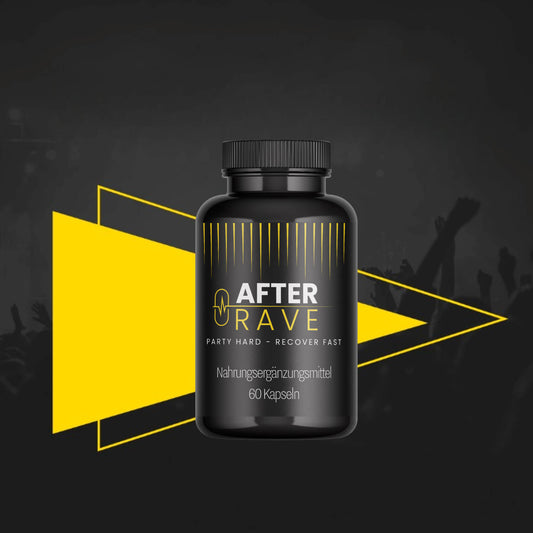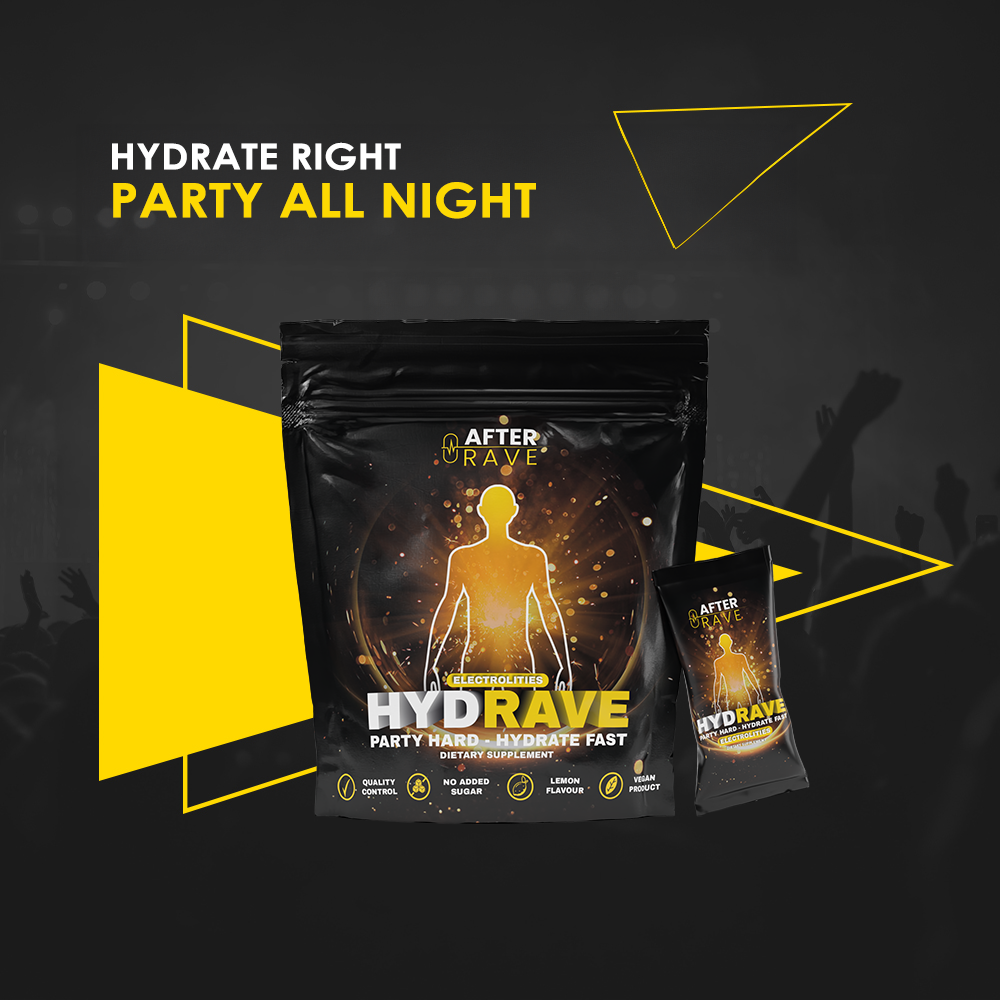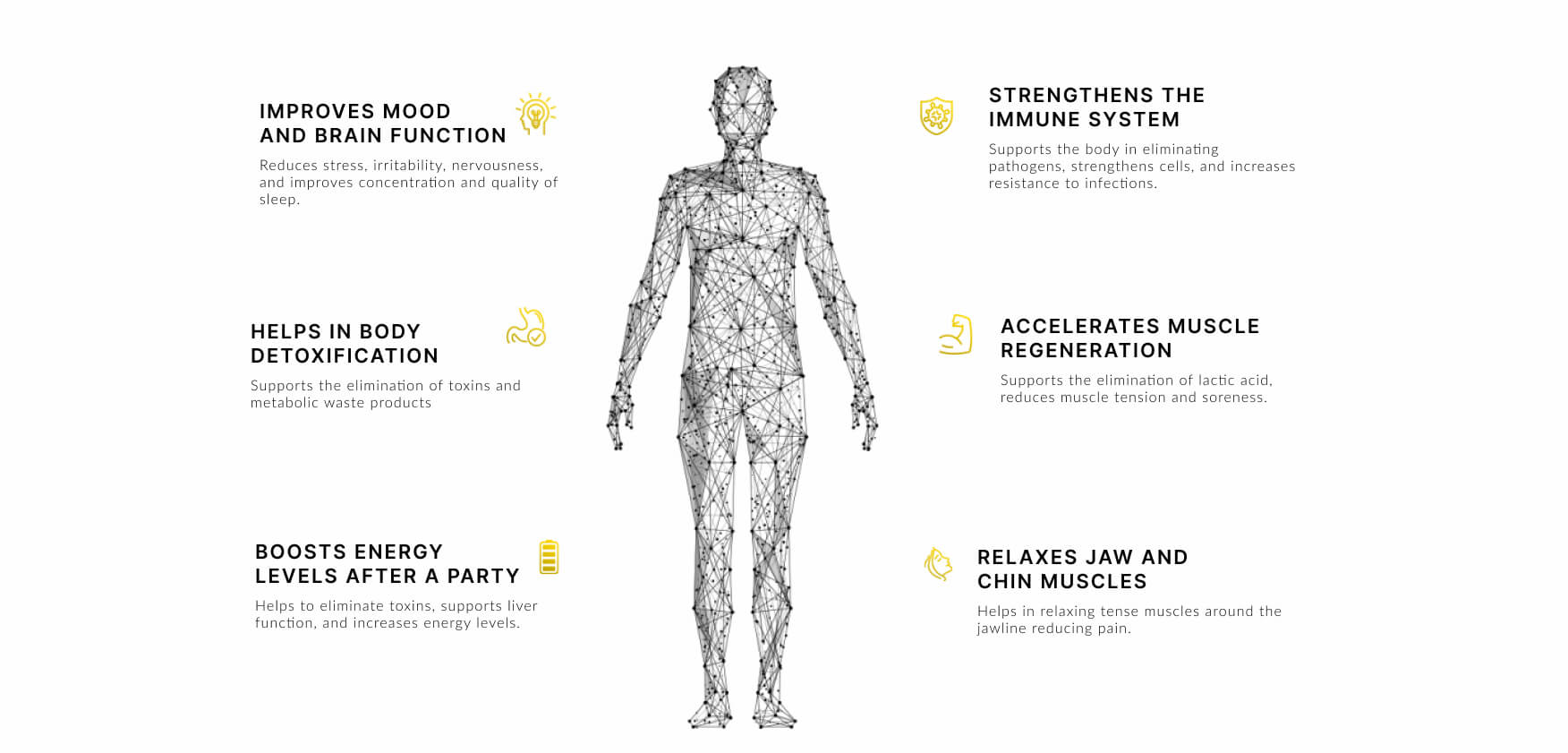

THERE IS A NEED, THERE IS A SUPPLEMENT
Reduce 'day after' damage with After Rave and HydRAVE
Meet After Rave and HydRAVE - these are innovative dietary supplements designed to support the body's recovery after intense events such as raves parties and festivals. Their advanced formula helps to minimise the negative effects associated with intense partying not only with alcohol ❄️ 😈
Why choose After Rave and HydRave?
After Rave and HydRave are dietary supplements that have been created for fast and effective recovery after even the longest parties(and after parties) . With a unique combination of ingredients to support both the physical and mental aspects of health, After Rave and HydRave are ideal for anyone who wants to get back into full shape quickly.Don't wait any longer - take care of yourself and your well-being after every party. Try After Rave and HydRAVE and see how quickly you can recover!

After Rave is your essential after a night of adventures. Its active ingredients effectively reduce the negative effects of partying hard, not only with alcohol, support the return to everyday duties and support the body's regeneration. Thanks to it, your body can recover faster, minimising the negative effects of mental and physical fatigue.HydRAVE, on the other hand, is a guarantee of adequate hydration and energy maintenance during the fever of a night of partying. It provides essential electrolytes that maintain your body's water-electrolyte balance, preventing overheating and dehydration. Its unique formula also supports energy production and delays the sensation of fatigue, so you can enjoy partying all night long.

After-Rave and HydRAVE are indispensable products for everyone who loves to have fun but cares about their health. Our supplements are ideal for conscious party-goers who want to enjoy every moment without worrying about the negative effects of intense partying.Why After-Rave and HydRAVE?Health first - our products support your body's recovery, helping to minimise the negative health effects after an intense night out.Better wellbeing - thanks to carefully selected active ingredients, After-Rave and HydRAVE help to improve your mood and wellbeing, reducing feelings of fatigue and deprivation. Mental protection - we take care of your mental health by supporting the regenerative processes of the nervous system.Increased productivity - after a party with After-Rave and HydRAVE, you recover more quickly, allowing you to be more productive and efficient.Improved social relationships - by eliminating feelings of anxiety and deprivation, our supplements help you maintain healthy social relationships.
Take care of faster regeneration
After RAVES!

After Rave


After Rave + HydRAVE
Odkryj idealne połączenie dla ochrony Twojego organizmu, poprawy samopoczucia i zwiększenia energii...

What is After Rave?
✨ Regenerate after the longest rave!
Don't let intense partying take away your enjoyment of life. Choose After-Rave and HydRAVE and party without fear!

More than a hangover pill!
We know that everyone sometimes needs a break from the everyday life that overwhelms us every day. We like to party from time to time and reset our brains.The problem is that after a party you usually have to get back to life quickly, and sometimes even to work (the worst). The truth is that this phenomenon is the result of toxic substances in your body.

That's why:
you feel tired, sleepy, anxious and irritable, you have a bad mood, anxiety and problems concentrating, you feel aversion to work, to going out and to socialising, you feel a sense of meaninglessness and inner emptiness, you feel that even a few days after the party you are not yourself.

You see!
If you have been depleted of your happy hormone, vitamins and minerals due to drug abuse, it makes perfect sense to replenish these substances as quickly as possible. We have developed After Rave to help you recover quickly. It is a modern complex of 11 active ingredients which reduces the unpleasant state of descent and speeds up the recovery even after the thickest party.
What do you find inside an After Rave capsule? Check out the more than 100 scientific studies on which we based the composition of After Rave
Trypophan
Tryptophan is an essential amino acid - it must be supplied externally as the body is unable to produce it on its own. It is an essential component for building proteins, hormones and neurotransmitters. Some studies suggest that it is a precursor of serotonin, a neurotransmitter linked to mental wellbeing [1]. It is possible that tryptophan deficiencies may be associated with reduced mental wellbeing following stimulant use [2], and tryptophan supplementation may have an impact on mental mood [3]. There are suggestions that tryptophan supplementation may increase tryptophan activity in the body compared to dietary tryptophan, as it may reduce competition with other LNAA amino acids that may carry a pronounced tryptophan effect [19]. This is compounded by the relatively low intake of tryptophan in the average person's diet, which is estimated to be around 1 gram per day averaged [20].Properties:Tryptophan is a precursor of serotonin, which is a neurotransmitter often associated with mood regulation and emotional control. Some sources suggest that serotonin deficiencies may be associated with the side effects of substances such as MDMA [4]. It is possible that tryptophan is associated with sleep, as it is a precursor to melatonin, a hormone that plays a role in regulating the sleep cycle [5] - the quality of which can be reduced by both the shift of bedtime relative to nighttime [6], as well as the use of many recreational drugs, such as MDMA [7]. Some studies suggest that MDMA use may affect serotonin metabolism, including by decreasing serotonin stores, decreasing serotonin receptor responses and decreasing tryptophan hydroxylase enzyme activity [8, 9, 10, 11]. Tryptophan supplementation may show beneficial effects on the psychological well-being of individuals who have experienced drug-related side effects [12, 13]. Some sources suggest that frequent MDMA use may affect tryptophan metabolism, and avoidance of this substance is recommended as a preventative measure [14]. There are suggestions that due to the pharmacokinetics of MDMA, which has a half-life of 8-9 hours, there may be a potential risk of serotonin syndrome during the period of MDMA activity in the body (equal to the five half-life of the compound). In After-Rave, tryptophan was used as a precursor of serotonin, which, unlike 5-hydroxytryptophan (5-HTP), does not bypass the enzyme tryptophan hydroxylase [16], providing a protective buffer against excessive serotonin concentrations that can lead to the health-threatening - and in some cases life-threatening - serotonin syndrome. According to some sources, the risk of serotonin syndrome as a result of tryptophan use is described as very unlikely to occur [17], whereas in the context of 5-HTP use - such a risk may be real [18], even more so in the face of circulating MDMA in the body.
List of scientific sources (to find the study easily, paste it into Google):
- doi: 10.1016/s0091-3057(01)00670-0.
- doi.org/10.3389/fendo.2019.00158
- doi: 10.1016/s0165-1781(00)00117-7
- doi: 10.3310/hta13050.
- doi.org/10.1093/nutrit/nuab027
- doi: 10.2147/NSS.S134864
- doi: 10.1002/hup.1233
- doi: 10.1016/s0091-3057(01)00711-0
- doi: 10.1016/j.forsciint.2011.04.008
- doi: 10.1093/brain/ awq103.
- doi: 10.2147/SAR.S37258
- doi: 10.1097/MCO.0000000000000237
- NBK545168
- doi: 10.1007/s00213-003-1463-5
- doi: 10.1097/00007691-200404000-00009
- NBK560856
- doi: 10.3390/ijms22010181
- „Demystifying serotonin syndrome (or serotonin toxicity)” Can Fam Physician. 2018 Oct; 64(10): 720–727.
- doi: 10.5152/jbachs.2017.240
- doi: 10.3945/jn.111.157065
Acetyl-L-carnitine (ALCAR)
Acetyl-L-carnitine (ALCAR) is a molecule that is a combination of carnitine and an acetyl group [1]. Carnitine can regulate fatty acid metabolism in the body, while the acetyl group is used in many areas, including being a component for the construction of acetylcholine [2, 3], a neurotransmitter responsible for, among other things, memory consolidation or the ability to maintain attention. This makes it all the more easy for ALCAR to replenish the pool of this neurotransmitter, thanks to its structure, which may allow it to easily penetrate the blood-brain barrier [2]. Some studies suggest that ALCAR may have a number of health-promoting properties, influencing metabolic health, the regularity of the cell's energy processes, or supporting cognitive function [4].Properties:Some studies suggest that ALCAR may exhibit a broad spectrum of neuroprotective effects, including by supporting aerobic metabolism, promoting blood circulation in the brain, antagonising the excitotoxic effects of glutamate and thus may prevent neuronal death [5]. When exposed to MDMA, ALCAR can exert effective neuroprotective effects against MDMA-induced neurotoxicity (in pre and postadministration against MDMA), at the cellular level it can reduce mitochondrial DNA deletion, improve respiratory chain expression and prevent the reduction of serotonin activity in several brain areas [6]. Carnitine itself, by promoting fatty acid transport, may enhance the properties of the neuronal mitochondrial membrane, protecting it from oxidative stress (and consequent neuronal damage) [6], which can occur during the use of, for example, MDMA as a result of the hyperthermia that occurs [16, 17]. Some studies suggest that ALCAR, through its beneficial effects on cellular health parameters and acetylcholine metabolism, may benefit the mental state of individuals who struggle with depression [7]. Reduced mental wellbeing is one of the common consequences of the abuse of many psychoactive substances, such as MDMA [8], as are nightmares or difficulty concentrating [9], which ALCAR can support [10, 11]. Substances, like MDMA, can lead to liver damage (hepatic encephalopathy can occur in some users) and severe liver failure [12, 13]. Some studies suggest that ALCAR may have the property of preventing hepatic encephalopathy and restoring normal organ function [14]. This is important because many psychoactive substances, such as MDMA and ethanol, are metabolised by the liver [15]. ALCAR can reduce symptoms of physical fatigue and mental fatigue [11, 18], which often occur after discontinuation of recreational drugs such as MDMA and other amphetamines and their derivatives [9, 19].List of scientific sources (to find the study easily, paste it into Google)
doi: 10.1038/sj.mp.4000805
doi: 10.1196/annals.1320.003
doi: 10.1007/BF00973749
doi: 10.2741/4459.
doi.org/10.1038/sj.jcbfm.9591524.0037
doi.org/10.1016/j.neuroscience.2008.10.041
doi: 10.1016/j.ejphar.2015.03.011
doi: 10.1016/s0091-3057(01)00711-0.
Psychiatr Danub. 2013 Jun;25(2):175-8.
doi: 10.1093/ajcn/86.5.1738.
doi: 10.1097/01.psy.0000116249.60477.e9.
Vet Hum Toxicol. 2001 Apr;43(2):99-102.
doi: 10.4037/aacnacc2019852.
doi: 10.1007/s10620-008-0238-6
doi: 10.5812/ijhrba.21076
doi: 10.3310/hta13050.
doi: 10.1016/j.ejphar.2004.07.006.
doi: 10.1016/j.archger.2007.03.012
doi: 10.1176/ajp.156.1.41
CDP-Choline (citicoline)
CDP-choline is a molecule that is a combination of choline together with cytidine. Choline is a component for the production of the neurotransmitter acetylcholine, which is closely linked to memory and largely determines clarity of thought [1]. Some studies suggest that cytidine converts to uridine, a compound that influences synaptic membrane plasticity [2] and may contribute to the enhancement of the neurotransmission of dopamine - which influences the ability to maintain attention, the desire to act, gives satisfaction from the task completion process, and is linked to libido. Properties:Some studies suggest that cytidine, converted to uridine, can enhance dopamine activity by increasing the concentration of the transporter for dopamine DAT [3], by increasing the amount of dopamine released from a stimulated neuron [4], and by increasing the density of dopamine receptors [5]. CDP-choline can reduce decreases in dopamine secretion when neurons are affected by neurotoxins [6, 7], through a protective mechanism in the dopamine neuronal area. It may promote recovery from addictions to drugs such as cocaine [9], alcohol or marijuana smoking [9] due to its effects on the mesolimbic and mesocortical dopaminergic systems [10]. In a study using CDP-choline, a decrease in the frequency of cocaine use, a reduction in the desire to induce euphoria with cocaine and a decrease in perceived cocaine craving were observed in cocaine users [8], suggesting its properties may reduce the mechanism of cocaine dependence. CDP-choline may inhibit the reduction of the brain's grey matter volume in exposure to amphetamines [11], which is the origin of the popular party drug MDMA [18], as well as the attraction to this type of substance in regular users (as opposed to the placebo group). It can reduce errors associated with, among other things, difficulty in maintaining focus [12], indicating its property to improve the ability to maintain attention in concentration disorders. May influence the maintenance of the activity of the ATP-producing enzyme, acetylcholinesterase, promoting health at the cellular level [13]. It promotes glutathione activity [14] and reduces apoptosis [15], likely a consequence of preserving cell membrane plasticity, as shown in a study with experimentally induced stroke in rodents [16]. For THC abusers, it may improve emotional self-control, a disorder of which is a common symptom of drug use, and improves concentration in these individuals, deficits of which also co-occur with frequent substance use [17].List of scientific sources (to find the study easily, paste it into Google)
- doi: 10.2174/092986708783503203
- doi: 10.2174/156802611795347618
- doi: 10.2174/1871527311312010015
- doi: 10.1385/JMN:27:1:137
- doi: 10.1111/j.1476-5381.1991.tb12471.x.
- doi: 10.1080/10623320600934341
- doi: 10.1016/s0022-510x(03)00204-1
- doi: 10.1007/s002130050871
- doi: 10.1097/ADM.0b013e3181d80c93
- doi: 10.1016/0165-6147(94)90158-9
- doi: 10.1016/j.jpsychires.2021.09.006
- doi: 10.4236/fns.2012.36103
- doi: 10.1016/s0009-9120(00)00084-9
- doi: 10.1161/hs1001.096010
- doi: 10.1016/s0028-3908(02)00032-1.
- doi: 10.1016/j.neuint.2011.12.015
- Int J Neurol Neurother. 2015 Sep 30; 2(3): 1–8.
- doi: 10.1016/j.drugalcdep.2003.07.001.
L-theanine
L-theanine is an amino acid of non-protein origin. It is extracted from tea leaves (Camellia sinensis) [1]. Some studies suggest that it is a compound with a number of functions for the brain - through a calming mechanism, to improving memory, concentration abilities and many other aspects related to proper brain function.Properties:May inhibit the excitotoxic effects of glutamate on neurons [2]. Some psychoactive substances, such as MDMA [3], increase glutamate activity to a neurotoxic degree, which translates into side effects in the neuronal area. There are suggestions that it increases alpha wave activity in the brain, which is associated with relaxation [4]. It may improve memory and concentration [5], thereby to some extent offsetting the side effects of psychoactive substances that interfere with these processes. It may reduce the neurotoxic aspect of stress (including oxidative stress) [6, 7], which is endocrinally induced by psychoactive substances of the amphetamine type, such as MDMA [8]. In addition, it may have a beneficial effect on glutathione activity, which counteracts the cell-damaging aspect of oxidative stress [2]. Some studies indicate that it has a calming effect on the central nervous system [9] - without a dementing effect - thus may reduce the stimulant effects of selected psychoactive substances [10, 11] and facilitate sleep. It can reduce the harm of THC in terms of cognitive brain function [12], thereby reducing negative effects on parameters such as memory. It can support mental health by reducing symptoms of its disturbed state such as anxiety [13]. Anxiety is one of the common complications of regular psychoactive substance use [14].List of scientific sources (to find the study easily, paste it into Google):
- doi: 10.1089/jmf.2020.4803
- doi: 10.1016/j.canlet.2004.03.040
- doi.org/10.1016/B978-0-12-800212-4.00038-8
- Ito K, Nagato Y, Aoi N, et al. Effects of Ltheanine on the release of alpha-brain waves in human volunteers. Nippon Nogeikagaku Kaishi 1998;72:153-157.
- doi: 10.1016/j.biopsycho.2007.09.008
- doi: 10.1016/j.fct.2006.03.014
- doi: 10.1016/j.biopsycho.2006.06.006
- doi: 10.1097/FBP.0000000000000060.
- doi: 10.1080/07315724.2014.926153
- doi: 10.1100/tsw.2007.214
- doi:10.1016/j.smrv.2011.03.004
- doi: 10.1523/JNEUROSCI.1050-20.2020
- doi: 10.4088/JCP.09m05324gre
- doi: 10.1177/0269881108097631.
Alpha lipoic acid (ALA)
A unique feature of ALA is its ability to be soluble in both water and lipids, making it a compound that can penetrate - and have an effect - in all cell types and tissues of the body [3]. Human studies have shown that ALA can slow neurodegeneration in people with Alzheimer's disease by reducing inflammation [4,5,6]. Many psychoactive substances induce inflammation, e.g. through hyperthermia, excitotoxicity [7,8,9,10,11,12] - ALA may reduce the harmfulness of these processes. It shows protective potential against the neurotoxic effects of MDMA [13]. In a rodent study, ALA dosed 30 min prior to drug administration did not inhibit the hyperthermic effect itself, however, it completely prevented serotonin deficits and the response from glial tissue (responds with production of pro-inflammatory cytokines). Thus, ALA can significantly reduce the neurotoxic oxidative stress induced by MDMA supply. It also shows protective effects on neurons at the mitochondrial level when administered with highly neurotoxic agents such as chemotherapy [14].List of scientific sources (to find the study easily, paste it into Google):
- doi: 10.1177/03946320090220S309
- Treatment of carpal tunnel syndrome with alpha-lipoic acid”; G Di Geronimo , A Fonzone Caccese, L Caruso, A Soldati, U Passaretti; Eur Rev Med Pharmacol Sci. 2009 Mar-Apr;13(2):133-9.
- doi: 10.3389/fphar.2011.00069. eCollection 2011.
- doi: 10.1016/j.addr.2008.04.015
- doi: 10.1007/978-3-211-73574-9_24
- doi: 10.1155/2013/454253
- doi: 10.1177/0960327110370984.
- doi.org/10.1016/B978-0-12-800212-4.00038-8
- doi: 10.1152/ajpregu.1997.273.5.R1771
- doi: 10.1016/s0891-5849(99)00014-3
- doi: 10.1080/10715760000300121
- doi: 10.1016/0304-3940(94)90593-2
- doi: 10.1097/00001756-199911260-00039
- doi: 10.1016/j.expneurol.2008.08.013
Vitamin B1
Vitamin B1 is an essential vitamin that, among other things, is involved in cellular energy processes, mainly linked to glucose metabolism [1]. Some studies suggest that its deficiency may lead to nervous system disorders, which may be compounded by the use of narcotic substances or dehydration.Properties:It is widely recognised that vitamin B1 is one of the key vitamins involved in alcohol metabolism, and its additional supply may reduce post-alcohol hangover [2] by supporting the enzyme that breaks down acetyl-aldehyde. There are suggestions that vitamin B1 may improve mental mood even at relatively small amounts [3]. Mental self-esteem is one of the key areas that can be affected by recreational drug use or sleepless nights. Deficiency of this vitamin can manifest as increased fatigue [4, 5] or a tendency to irritability [4], which can also be exacerbated by narcotic substances.List of scientific sources (to find the study easily, paste it into Google):
https://ods.od.nih.gov/factsheets/thiamin-healthprofessional/
doi: 10.1186/1471-2210-8-10
doi.org/10.1007/s002130050163
doi: 10.1016/j.ncl.2013.02.002
doi: 10.1089/acm.2013.0461
Grapevine seed extract (oligomeric proanthocyanidins)
Oligomeric proanthocyanidins (OPCs), of which grape seed extract is a source, are compounds with very high antioxidant potential, and may thus have anti-inflammatory functions that can protect various types of tissue from damage [1].Properties:OPCs may exhibit antioxidant effects on brain cells, potentially reducing the progression of neurodegenerative processes [2, 3]. Some studies suggest that OPCs may have beneficial effects on brain functions responsible for maintaining attention, speech or memory - as shown in a study on healthy elderly individuals [4]. There are suggestions that OPCs may reduce the hepatotoxicity of even such potent agents as chemotherapeutic pharmaceuticals [5, 6]. The liver is responsible for metabolising most substances supplied to the body, including narcotic substances [7], which themselves can impair liver function, thereby potentiating their harmful effects on the body [8, 9]. Some studies have shown the efficacy of proanthocyanidins in protecting against alcohol-induced toxicity and oxidative damage [10, 11].List of scientific sources (to find a study easily, paste it into Google):
doi: 10.3390/antiox6030071
doi: 10.3945/an.114.007500
doi: 10.1007/s10571-009-9403-5
doi: 10.3389/fphar.2017.00776
doi: 10.1089/jmf.2011.0291
doi: 10.1080/01635581.2015.1029639
doi: 10.1080/10401230802177656
Vet Hum Toxicol. 2001 Apr;43(2):99-102.
doi: 10.4037/aacnacc2019852
doi: 10.1097/WNR.0000000000000867.
doi: 10.1093/alcalc/agaa031.
Coenzyme Q10 (ubiquinone)
Coenzyme Q10 is a lipophilic antioxidant produced by the body, whose highest concentration is reached in the cell mitochondria - the so-called 'energy furnaces' of cells [1]. This compound is thought to be mainly responsible for energy production and the reduction of oxidative stress, thus may protect cells from damage [2].Properties:Migraine headaches are - for those with such a tendency - one of the possible complications of drug substance abuse, such as MDMA [3]. Some sources suggest that Q10 may be an effective treatment for migraines [4, 5], and supplementation with it may reduce migraine frequency, duration and pain intensity [6]. In the context of migraines, there are suggestions that it shows synergy with L-carnitine [7], also included in the formulation.The need for coenzyme Q10 may increase significantly with oxidative stress [8], which is associated with the use of many psychoactive substances, such as cocaine, MDMA and alcohol. The lower the Q10 reserves, the greater the body's susceptibility to free oxygen radical-induced side effects may be [2, 9]. Some studies suggest that it supports bodily functions even in healthy individuals, possibly improving exercise performance [10,11,12], including through its ability to reduce damage to cell phospholipid membranes by free oxygen radicals, thus may reduce fatigue after a sleepless night and the use of stimulants with a negative profile of effects on cells. In the context of protective effects on the brain - coenzyme Q10 may exhibit protective effects on cellular mitochondria against oxidative stress [13,14,15], potentially reducing neurodegeneration [16,17,18,19]. In the context of stimulants, there are suggestions that: - may protect against neuronal damage induced by MDMA, cocaine, methamphetamine, alcohol [20,21,22,23] - may prevent cocaine-induced cardiac dysfunction [24].List of scientific sources (to find a study easily, paste it into Google):
- NBK531491
- doi: 10.4103/0975-7406.84471
- doi.org/10.1111/j.1742-7843.2007.00159.x
- doi: 10.1136/bmjopen-2020-039358
- doi: 10.1186/1129-2377-16-S1-A139
- doi: 10.1111/ane.13051
- doi: 10.1177/0333102418821661
- PMC3096178
- doi: 10.1111/jfbc.13145
- doi: 10.2174/1389200216666151103115654.
- doi: 10.1186/1550-2783-10-24
- doi: 10.1519/JSC.0b013e3181a61a50.
- doi: 10.3390/cells9051177
- doi: 10.1016/j.redox.2018.01.008
- doi: 10.1016/j.mito.2019.07.003
- doi: 10.2174/1568026615666150827095252
- doi: 10.1007/s11011-021-00795-4
- doi: 10.1016/j.brainresbull.2019.01.025
- doi: 10.1073/pnas.95.15.8892
- doi: 10.2174/138920110791591436
- doi: 10.1016/j.brainres.2005.07.009
- doi: 10.1007/s11064-005-9025-3.
- doi: 10.1111/fcp.12003. Epub 2012 Oct 12.
- doi: 10.1016/j.freeradbiomed.2010.05.024.
Vitamin B6
Vitamin B6 is a hydrophilic nutrient that has many functions in the body. It can affect the functioning of the nervous system, regulate mood and organ function [1].Properties:Vitamin B6, along with other micronutrients - folic acid, magnesium, calcium, iron - is involved in metabolic processes such as the production of 5-hydroxytryptophan and then serotonin from the amino acid L-tryptophan, via the enzyme tryptophan hydroxylase [2]. It is considered essential for this process. Deficiency of this vitamin may be associated with emotional disturbances in the dopamine, serotonin, GABA pathways, which may manifest as depression or anxiety disorders [3, 4]. Some human studies suggest a 2-fold higher risk of depression in people with pyridoxine deficiency [5]. Vitamin B6 may reduce the chances of neurological disorders due to its regulatory effect on homocysteine levels [6,7,8].List of scientific sources (to find a study easily, paste it into Google)\
- doi: 10.3390/molecules15010442.
- doi.org/10.3389/fmicb.2022.873555
- doi: 10.1007/s10545-005-0243-2
- PMID: 18494537
- doi: 10.1080/07315724.2008.10719720
- doi: 10.1002/14651858.CD004393
- doi: 10.1056/NEJMoa011613
- doi: 10.1002/gps.2303.
Folate - Glucosamine salt
Folate can participate in the formation of the S-adenosine-methionine (SAM-e) molecule, a methyl group donor that positively influences the glutathione pathway (a very potent antioxidant), can positively influence mental wellbeing and regulate the function of all genes [6,7,8]. It has the advantage over folic acid that it can be the ultimate active form of folate, bypassing the limiter in the form of the enzyme dihydrofolate reductase (DHFR), which, in people with its dysfunction, causes unmetabolised to MTHF folic acid to lie biologically inactive in the body [9,10,11]. An additional benefit of supplementation with the 5-MTHF form is that in diagnostic tests, unlike folic acid, it does not mask vitamin B12 deficiency [9]. It can convert tryptophan to serotonin at the transition stage to the 5-hydroxytryptophan form and further at the transition stage of 5-hydroxytryptophan to serotonin [12].List of scientific sources (to find the study easily, paste it into Google):
doi: 10.1007/s10545-010-9177-4
doi: 10.1016/j.brainres.2008.07.074
doi: 10.1002/iub.133
doi: 10.2174/156652409787847146
doi: 10.1007/s10545-010-9159-6
doi: 10.3748/wjg.v16.i11.1366
PMID: 18950248
doi: 10.1016/0165-0327(94)90014-0.
doi: 10.1002/bjs.6670
doi: 10.1073/pnas.0902072106. Epub 2009 Aug 24.
doi: 10.3945/ajcn.2010.29499
doi.org/10.3389/fmicb.2022.873555
Vitamin B12 - Methylcobalamin
Methylcobalamin is the coenzymatic form of vitamin B12, a micronutrient essential for life, responsible for the formation of red blood cells or nerve conduction. The correct status of this vitamin translates into wellbeing and cognitive function [1-5]. Properties: Methylcobalamin is absorbed much better than other available forms of vitamin B12, even in cases of impaired production of vitamin B12 transport proteins in the stomach and small intestine [4], where the number of genetic mutations involving such disorders is more than 300 per current day [3]. Regulates genetic function [3]. Lowers toxic homocysteine levels [4]. Cobalamin deficiency results in impaired production of white and red blood cells [4-5]. Cobalamin deficits have been linked in the literature to difficulty in decision-making [7,8,9], negative changes in personality and mental well-being [7, 8]. It is essential for the proper functioning of our memory [7,8, 10] and for regularities in nerve conduction by affecting nerve integrity [11]. It is essential for the synthesis of dopamine [12] and serotonin [13], whose metabolism is disrupted with the use of narcotic substances such as cocaine [14], methamphetamine [15], MDMA [16], THC [17].List of scientific sources (to find a study easily, paste it into Google):
- doi: 10.1177/15648265080292S117
- doi: 10.1111/j.1365-2141.2009.07937.x
- doi: 10.1016/j.ajpath.2017.08.032
- PMID: 12643357
- PMID: 21671542
- doi.org/10.1007/s12603-014-0525-1
- doi: 10.1176/appi.neuropsych.11020052
- doi: 10.3945/an.112.002535
- Knopman DS, others. „Neurology” 2001;56:1143 (12 pgs)
- doi: 10.4103/ijp.ijp_1159_20
- doi: 10.4103/0253-7176.92051
- doi.org/10.3389/fmicb.2022.873555
- doi: 10.1151/spp05314
- doi: 10.1016/s0014-2999(99)00538-5
- doi: 10.3310/hta13050.
- doi:https://doi.org/10.1016/j.biopsych.2013.05.027
What do you find in the composition of HydRAVE? Check out the more than 100 scientific studies on which we based the composition of HydRAVE
Ornithine HCL
Why is Ornithine HCL in HydRave?Ornithine HCL is an amino acid that is not one of the basic 20 amino acids that build proteins, but is used to break down ammonia to urea (urea Krebs cycle), right alongside arginine and citrulline [1]. Ammonia is a product of protein metabolism in the body, which, as exercise progresses, can contribute to feelings of fatigue [2]. Ornithine is one of the key components of the ammonia scavenging cycle [3], which can reduce perceived psychophysical fatigue [4, 2]. In addition, ornithine may contribute to improved sleep quality [5] and reduce the negative symptoms of excessive alcohol consumption, such as a hangover [6].The use of ornithine HCL in HydRave may result in reduced fatigue during long hours of activity, reduced perceived fatigue, improved sleep quality after partying, and a partial reduction in the effects of alcohol consumption. Properties:➔ Reduces fatigue:Ornithine, being an important part of the Krebs cycle in ammonia removal, is key in the production of an enzyme (carbamoylphosphate synthase), which helps keep ammonia levels in check, reducing perceived physical and mental fatigue [3, 4, 2]. These effects can be seen at doses starting at 2,000 mg of ornithine hydrochloride [8].➔ Effects for many hours:About 45 minutes after ingestion, ornithine reaches effective concentration in the blood [7] and remains high for another 4-6 hours, after which it begins to drop [8]. This translates into many hours of ornithine benefits in the body after a single dose.➔ Improves sleep:Low doses of ornithine, such as 500 mg in hydrochloride form, may improve sleep quality by reducing the time it takes to fall asleep and having a positive effect on sleep continuity in people who have trouble sleeping due to stress [5]. Additionally, it may reduce daytime cortisol levels, which translates into a reduced stress response in the body.➔ Reduces hangover effects:Doses of 500 mg of ornithine HCL consumed during alcohol consumption may reduce hangover symptoms the next day. Studies indicate that people who consumed alcohol along with ornithine had lower cortisol levels upon waking and better moods (less fatigue, less lethargy, more positive attitude, less confusion) [6].Side effects:➔ Larger amounts of ornithine may cause diarrhea in some people due to saturation of the transporter for the amino acid [9]. This effect can occur at doses of 20g and up, which is a very large amount.List of scientific sources (to find a study easily, paste it into Google):
AAKG (arginine alpha ketogluratan)
Why is AAKG (arginine alpha ketogluratan) in HydRave?AAKG is a combination of the amino acid L-arginine with the molecule alpha ketogluratan (AKG), which provides a synergistic effect of both compounds. L-arginine is a precursor to nitric oxide (NO), which improves blood circulation and relaxes blood vessels [1]. This increases the efficiency of supplying skeletal muscle with oxygen and glucose, essential for energy processes [1].AAKG can also promote the removal of metabolic products [1]. Arginine is a substrate in the urea cycle, where, together with citrulline and ornithine, it contributes to the removal of ammonia, thereby reducing psychophysical fatigue [2]. AKG, used in the Krebs cycle, is essential for energy production in the form of ATP. AKG promotes amino acid production, nitrogen balance, and acts as an antioxidant [3, 4].Properties:Arginine:Arginine cooperates with ornithine and citrulline in the urea cycle, helping to remove ammonia from the body [2].It is converted to ornithine by the action of arginase and then to citrulline, leading to a reduction in blood ammonia concentrations [2, 6, 7]. It can be converted to citrulline and nitric oxide (NO), which improves blood circulation and lowers blood pressure [8, 15, 16].Arginine supplementation reduces the so-called oxygen debt and improves aerobic capacity, extending the duration of continued exercise [19]. It increases the cellular bioavailability of ornithine, showing a synergistic effect [20].AAKG:The combination of arginine with AKG increases its bioavailability [13].AKG promotes the conversion of ammonia to glutamine, reducing its level in the blood [21].It acts as an intermediate compound in the metabolism of glutamine, buffering ammonia [23]. Exhibits antioxidant activity, eliminating reactive oxygen species (ROS) and promoting the enzymes responsible for their removal [4, 24].Side effects:Diarrhea or bloating may occur due to nitric oxide production, which increases water resorption in the intestine [25]. This effect is not expected to occur at doses below 10g [26].AKG by itself has no potential for side effects [27], but when combined with arginine (AAKG), dizziness or heart palpitations may occur [28].List of scientific sources (to find a study easily, paste it into Google):
- DOI: 10.1042/bj3360001
- DOI: 10.1186/1750-1172-7-32
- DOI: 10.1016/j.tem.2021.11.003
- https://doi.org/10.1155/2018/3408467
- DOI: 10.2147/DMSO.S369090
- DOI: 10.1016/0968-0896(94)85009-7
- doi: 10.18632/oncotarget.135
- DOI: 10.1002/biof.1099
- DOI: 10.1046/j.1365-2125.1998.00803.x
- DOI: 10.1046/j.1365-2125.1999.00883.x
- DOI: 10.1111/j.1440-1681.2007.04638.x
- DOI: 10.1016/j.pharmthera.2007.03.002
- DOI: 10.1016/j.nut.2006.06.003
- DOI: 10.1016/j.niox.2007.07.001
- DOI: 10.1152/physrev.2001.81.1.209
- DOI: 10.1038/ajh.2012.20
- DOI: 10.2165/11596860-000000000-00000
- DOI: 10.1152/japplphysiol.00722.2009
- DOI: 10.1152/japplphysiol.00503.2010
- PMID: 1930251
- DOI: 10.1023/a:1006534305943
- DOI: 10.1016/0261-5614(93)90150-3
- DOI: 10.1007/BF01581777
- PMID: 3495276
DOI:https://doi.org/10.1093/ajcn/83.2.508S - . DOI: 10.1016/j.ghir.2004.12.004
- PMID: 21791173
- DOI: 10.1177/0960327109104498
L-Cytrulline
Why is L-Cytrulline in HydRave?L-Cytrulline is a non-protein amino acid that converts to arginine when ingested in the kidneys. Then, it can be used to produce nitric oxide, which can improve blood circulation. Synthesized in the body from arginine and ornithine, oral intake of citrulline can reduce the consumption of these amino acids, increasing their availability for other processes such as the urea cycle [1, 2, 3, 4]. Citrulline can effectively increase the production of nitric oxide, which, according to some studies, can affect exercise parameters, cardiovascular health and improve erections in men. Properties:➔ Oral administration of citrulline: May lead to its conversion of more than 80% by the kidneys to arginine using the enzymes argininosuccinate synthase and argininosuccinate lyase, which may lead to increased arginine concentration in the blood [3, 4, 5].➔ Parallel dosing of citrulline with arginine: May reduce the threshold for effective arginine dose [6]. Administration of citrulline may increase the effective use of arginine. Higher doses of citrulline are converted less and less efficiently to arginine, suggesting that citrulline alone may not fully cover the effects that drastic increases in serum arginine concentration bring. However, the supply of citrulline alone can raise blood arginine levels for a long time [7, 8].➔ Increases the concentration of other amino acids: It can increase the levels of arginine and ornithine used in the urea cycle, which can potentiate the rate of ammonia removal from the blood [9, 8, 6]. Efficacy in this regard begins with 2g of citrulline.➔ Improve erectile quality in men: Doses of 1,500 mg per day and above can improve erection quality by increasing nitric oxide production [10, 11]. This effect may last up to 3 hours after a single dose [6, 12], and twice-daily dosing may provide a 24-hour effect [13].➔ Improved bioavailability: Citrulline is better absorbed from the gastrointestinal tract than arginine, which may make it a more effective source of arginine [14].➔ Increases nitric oxide synthesis: It may improve blood circulation by increasing the concentration of arginine in the process. Citrulline is converted to L-arginine succinate and then to L-arginine, bypassing the urea cycle [15, 16]. Thus, it may be more effective than direct dosing of arginine [17, 18, 19, 20].➔ Increases ATP production: May promote the production of the energy molecule ATP, which is crucial for maintaining physical activity [21].➔ Reduces muscle soreness: May reduce muscle soreness after intense exercise [22].➔ Extends exercise time: May prolong exercise time until exhaustion [23].➔ No gastric discomfort: High doses of citrulline (as much as 15g) do not cause gastrointestinal complaints such as bloating or diarrhea, probably due to its good digestive absorption [6].List of scientific sources (to find a study easily, paste it into Google):
1.DOI: 10.1007/s00726-005-0235-4
2. DOI: 10.1152/ajpendo.00006.2011
3. DOI: 10.1113/jphysiol.2006.126029
4. DOI: 10.1093/ajcn/85.1.167
5. DOI: 10.1016/s0026-0495(97)90002-0
6. DOI: 10.1017/S0007114507841110
7. DOI: 10.1111/j.1365-2125.2007.02990.x
8. DOI: 10.1007/s00421-010-1509-4
9. DOI: 10.1152/ajpgi.00289.2007
10. DOI: 10.1016/j.urology.2010.08.028
11. DOI: 10.1111/j.1524-6175.2006.06026.x
12. DOI: 10.1080/09168451.2016.1230007
13. doi: 10.3390/nu11071679
14. DOI: 10.1097/MCO.0b013e32829fb38d
15.DOI: 10.2174/157488909788453004
16.DOI: 10.1016/j.niox.2007.07.001
17. DOI: 10.1073/pnas.90.1.193
18. DOI: 10.1093/ajcn/85.1.167
19. DOI: 10.1093/jn/134.10.2743S
20. DOI: 10.1161/circresaha.107.155028
21. DOI: 10.1016/j.ejphar.2011.05.068
Sodium
Sodium (Na) is an element whose intake plays an important role in maintaining the body's water balance, affecting the osmotic pressure of body fluids and cell hydration [1]. In addition, sodium helps maintain the action potential of cell membranes.Its deficiency can lead to the disappearance of the electrical potential in the nervous system, which can occur under conditions of increased demand, such as during intense physical activity and high ambient temperatures. This can result in nervous system disorders or even loss of consciousness. Sodium is one of the main elements responsible for the body's hydration status, which also enables it to dissipate excess heat and maintain optimal body temperature [2].Properties:Sodium chloride: ➔ Both excess and deficiency of sodium relative to potassium can be potentially harmful to the cardiovascular system [3, 4]. Adequate balance between sodium and potassium ions is crucial to ensure proper cardiac function.➔ During prolonged exercise, to prevent hyponatremia (a decrease in plasma sodium ion concentration), which can affect exercise capacity [5], a sodium supply of 300 to 600 mg per hour of exercise, in a 500-700 mg/L solution, is recommended [6]. The solution should not exceed a concentration of 1,000 mg/L due to a decrease in palatability.➔ Increased excretion of sodium and chloride ions with sweat can occur as early as exercise reaching 45% of VO2 max, which increases the need for sodium intake to prevent sodium deficiency [7].➔ Chloride ions, which are basic ions with a negative electrical charge, are involved in regulating water-electrolyte balance and maintaining the body's acid-base balance. Changes in the concentration of chloride ions are closely related to changes in the concentration of sodium ions [8].Sodium citrate: ➔ Sodium citrate can improve exercise capacity and reduce lactic acid levels in the blood, which is associated with fatigue [9, 20]. Citric acid plays an important role in the Krebs cycle, where it is used to produce energy in the form of ATP, which may contribute to improved muscle performance.List of scientific sources (to find a study easily, paste it into Google):
2. DOI: 10.1055/s-2007-971971
3. DOI: 10.1001/jama.2011.1729
4. DOI: 10.1093/eurheartj/ehaa586
5. doi: 10.1080/02640414.2011.614269.
6. doi: 10.3390/ijerph19063651
7. doi: 10.1007/s00421-018-4048-z
8.DOI: 10.1016/j.ejim.2011.11.013
9. DOI: 10.1007/BF00240418
10. DOI: 10.1186/s12970-019-0297-4
Potassium
Why Potassium is in HydRave?Potassium is an element that contributes to the proper functioning of cells in the body. It can perform the function of maintaining electrolyte balance, regulating blood pressure and transmitting electrical impulses in cells of the nervous system and muscles. It is considered crucial in ensuring that all muscles, such as the heart, can contract [1, 2].Potassium is obtained from plants - mainly vegetables, fruits, legumes - as well as meat and dairy products [3]. Potassium use in the body increases with the intensity and duration of physical activity undertaken, and its deficiency in plasma may be associated with cardiovascular disorders such as arrhythmias [4, 5, 6, 7].Properties:➔ Potassium contributes to maintaining the electrical voltage of cell membranes, which may determine the transmission of impulses through neurons and the ability of muscle tissues to contract [1, 2]. ➔ An adequate supply of potassium may reduce the risk of strokes and cardiovascular disorders [8, 9, 10, 11], likely due to its blood pressure-lowering properties [12, 13].➔ In people who have not been diagnosed with any diseases, some studies suggest that single doses of potassium can lower blood pressure [14]. This effect is also sometimes observed in people with hypertension [15, 16]. Thus, potassium may protect against spikes in blood pressure, as may occur, for example, in a state of over-stimulation of the nervous system [17].➔ The blood pressure-lowering effect is most pronounced in people who abuse salt on a daily basis, with a concomitant deficit in potassium intake and absence of blood pressure-lowering drugs [13, 18]. The effect itself is moderate but significant [12, 13].➔ Potassium may be responsible for fluid management and proper transmission of electrical impulses. Its low concentration in the body is probably the main cause of muscle cramps [19].➔ Interactions with drugs [20, 21]: - insulin - diuretics - potassium-binding drugs➔ Interactions with existing health disorders [22, 23]: - chronic kidney disease - diabetic ketoacidosis➔ Potential side effects: - nausea - vomiting - abdominal pain - diarrheaList of scientific sources (to find a study easily, paste it into Google):
1. DOI: 10.1152/advan.00121.2016
2. DOI: 10.1016/j.pharmthera.2023.108489
3. https://ods.od.nih.gov/factsheets/Potassium-HealthProfessional/
4. DOI: 10.1080/00015385.2020.1799573
5. DOI: 10.1002/fsn3.2478
6. DOI: 10.1177/2047487318780466
7. DOI: 10.1007/s10557-018-6783-0
8. DOI: 10.1016/j.jacc.2010.09.070
9. DOI: 10.1161/JAHA.116.004210
10. DOI: 10.1080/10408398.2023.2262584
11. DOI: 10.1136/bmj.f1378
12. DOI: 10.1371/journal.pone.0174967
13. DOI: 10.1016/j.ijcard.2016.12.048
14. DOI: 10.1017/S0007114507864853
15. DOI: 10.1161/01.HYP.0000158264.36590.19
16. DOI: 10.1681/ASN.V281302
17. DOI: 10.3389/fnbeh.2020.00080
18. DOI: 10.1161/JAHA.119.015719
19. DOI: 10.1123/jsr.2014-0293
20. DOI: 10.1152/advan.00121.2016
21. DOI: 10.1016/j.pharmthera.2023.108489
22. DOI: 10.1038/nrdp.2017.88
23. DOI: 10.1038/s41572-020-0165-1
Magnesium
Why Magnesium is in HydRave?Description:Magnesium is an element and an essential nutrient for the body, used in the conduction of the nervous system, energy production, blood pressure regulation, sugar control and many other biochemical processes. It can be used by more than 300 enzymes [1].Magnesium acts as an electrolyte, enabling the body to maintain fluid balance, and has a diastolic function for the nervous system - it is necessary for muscle fibers to relax after contraction [2].In food, magnesium is found mainly in dark leafy vegetables, nuts, seeds, whole grains, legumes, meat, and mineral water [3]. Many products are fortified with magnesium, such as breakfast cereals. About 20-40% of the magnesium we consume becomes bioavailable [4, 5]. It is estimated that more than 50% of the population does not get the right amount of magnesium with food, which can increase the risk of magnesium deficiency symptoms, such as cardiac dysfunction [3, 6, 7].Properties:➔ In people with dietary magnesium deficiency, supplementation may help regulate blood pressure spikes [8, 9], especially in people with chronic hypertension [10, 11, 12]. This effect may be most noticeable in people with metabolic disorders such as type II diabetes [13, 14].➔ There are studies that suggest that in people with insomnia caused by magnesium deficiency, magnesium supplementation may improve sleep quality [15, 16]. This is due to its effects on NMDA receptors (responsible for stimulating the central nervous system) and GABA receptors (responsible for relaxation), which may help regulate the sleep-wake cycle [17, 18].➔ Magnesium supplementation can reduce the frequency of migraine attacks and their severity by almost 50% [19, 20]. ➔ Magnesium may help regulate blood pressure and endothelial function by stimulating the production of nitric oxide [21].➔ The norm for daily magnesium intake is 310-400 mg for people aged 18-30 years, and 320-420 mg for people older than 31 years [22].➔ Two transport proteins, TRPM7 and TRPM6, are responsible for magnesium uptake [23, 24, 25]. TRPM7 is produced by all body tissues, while TRPM6 is mainly produced in the intestines. A genetic defect associated with TRPM6 production may lead to hypomagnesia [25].➔ Magnesium in the context of neurons in the brain acts in opposition to NMDA receptors relative to calcium ions [26, 27]. Low magnesium status may be associated with NMDA-r excitotoxicity [28, 29].➔ Sleep deprivation may decrease magnesium levels in the body and increase cortisol levels [30]. Magnesium supplementation may help achieve a state of calmness before sleep and improve sleep parameters [31].➔ Magnesium may be correlated with cardiac disorders such as arrhythmia [1], and its supplementation may reduce cardiac health incidents [32]. ➔ Magnesium supplementation may reduce blood pressure spikes associated with sharply increased adrenaline activity, as occurs when shock is experienced [33].➔ Magnesium in the form of citrate shows high bioavailability - up to 30% higher than magnesium oxide [40, 41].➔ Simultaneous supply of magnesium with calcium is unlikely to bring significant changes in the absorption of either element [42].Side effects: ➔ High doses of magnesium in supplement form may have a laxative effect [3, 43]. Unabsorbed magnesium salts can have an osmotic effect in the gastrointestinal tract and can induce gastric motility. Other adverse gastrointestinal symptoms such as nausea, abdominal pain, diarrhea may also occur.List of scientific sources (to find a study easily, paste it into Google):
1. PMID: 11811859
2. DOI: 10.1085/jgp.69.1.1
3. https://ods.od.nih.gov/factsheets/Magnesium-HealthProfessional/
4. DOI: 10.1079/bjn19950081
5. DOI: 10.1038/sj.ejcn.1601778
6. DOI: 10.1152/physrev.00012.2014
7. DOI: 10.1136/openhrt-2017-000668
8. DOI: 10.1161/01.hyp.31.1.131
9. DOI: 10.1038/jhh.2008.129
10. DOI: 10.1016/j.numecd.2009.01.002
11. DOI: 10.1038/ajh.2009.126
12. DOI: 10.1161/01.hyp.32.2.260
13. DOI: 10.1007/s12011-020-02157-0
14. DOI: 10.3389/fnut.2022.1020327
15. DOI: 10.1055/s-2002-33195
16. DOI: 10.1684/mrh.2010.0220
17. DOI: 10.1186/s12906-021-03297-z
18. DOI: 10.1007/s40675-017-0091-2
19. DOI: 10.1007/s00394-019-01905-w
20. PMID: 26752497
21. DOI: 10.3390/nu13010139
22. https://nap.nationalacademies.org/read/5776/chapter/1
23. DOI: 10.1097/MOG.0b013e3282f37b59
24. DOI: 10.1007/112_2006_0607
25. DOI: 10.1016/j.bbadis.2007.03.009
26. doi: 10.1016/S0006-3495(90)82626-6
27. DOI: 10.1038/307462a0
28. DOI: 10.1681/ASN.2008010098
29. PMID: 19780405
30. DOI: 10.1002/clc.4960270411
31. DOI: 10.1016/j.sleep.2010.09.012
32. DOI: 10.1111/j.1745-7599.2009.00460.x
33. DOI: 10.1161/01.HYP.0000146536.68208.84
34. DOI: 10.1038/ajh.2009.126
35. DOI: 10.1016/j.numecd.2009.01.002
36. DOI: 10.1111/j.1365-2362.2010.02422.x
37. DOI: 10.1002/14651858.CD009402.pub2
38. DOI: 10.1136/bmj.2.5660.804
39. PMCID: PMC2146789
40. DOI: 10.1080/07315724.1990.10720349
41. PMID: 14596323
42. „Bio-availability of calcium and magnesium from magnesium citrate calcium malate Implications for osteoporosis prevention” January 1997South African Medical Journal 87(9):1271-1276
43. DOI: 10.1097/00045391-200109000-00008
Calcium
Why Calcium is in HydRave?Description:Calcium is an element and micronutrient that is essential for maintaining normal body functions such as bone structure and cardiovascular health. It is mainly found in dairy dairy products, highly mineralized waters and in smaller amounts in selected plant products [1]. In the body, calcium is mainly stored in the bones in the form of osteoblasts [2], and the remaining amount is found in the bloodstream, serving a signaling function for the nervous system, among other things [3]. An adequate supply of calcium in the diet is important for the proper functioning of the body.Properties:➔ Calcium acts as an electrolyte, carrying an electrical charge and activating NMDA glutamate receptors, which are associated with neuronal plasticity and nervous system activity [4]. Thus, calcium is an important micronutrient for neuronal function.➔ With increased sodium expenditure, such as with sweat during intense exercise, there is a concomitant loss of calcium ions, which may suggest the need to supplement both elements [5].➔ Calcium is absorbed from the gastrointestinal tract in two sections of the intestine - the duodenum and the jejunum [6, 7]. This process is regulated by enzymes whose activity depends on blood calcium levels and vitamin D3 [7]. Consumption of dietary fiber may slow the passage of food content through the intestines, which may increase the efficiency of calcium absorption [8].➔ The recommended daily calcium requirement for an adult is 1000 mg [9]. The daily intake limit is 2,000-3,000 mg, where higher amounts may contribute to constipation.➔ Alcohol consumption may reduce the absorption of calcium from the gastrointestinal tract [10].➔ When taking certain medications, a time interval should be maintained between calcium preparations, as they can form poorly absorbed complexes, limiting drug absorption [11]. These drugs include thyroid hormones, osteoporosis medications, aspirin, some antibiotics, antifungals, gastrointestinal medications, anticoagulants, calcium channel blockers, beta-blockers, and iron preparations, among others.➔ People taking lithium should be wary of the risk of hypercalcemia when taking additional calcium preparations [12]. ➔ Calcium citrate has a higher bioavailability than many other forms of calcium on the market, such as calcium carbonate, which can result in 76% more of the element circulating in the blood than in the carbonate form [13, 14].Side effects: ➔ Calcium administered in supplement form in single high doses can cause such discomforts as abdominal pain, nausea, nausea, constipation, belching, abdominal cramps, and diarrhea [15, 16]. List of scientific sources (to find the study easily, paste it into Google):
1. https://ods.od.nih.gov/factsheets/Calcium-HealthProfessional/
2. DOI: 10.3390/jfb6041099
3. DOI: 10.1023/b:mcbi.0000009869.29827.df
4. doi: 10.1042/BST0371369
5. DOI: 10.1097/01.CSMR.0000306208.56939.01
6. DOI: 10.1152/ajpgi.1986.250.5.G561
7. DOI: 10.1016/0003-9861(80)90425-7
8. DOI: 10.1093/jn/123.8.1396
9. DOI: 10.1016/j.jada.2011.01.004
10. DOI: 10.1093/ajcn/72.2.466
11. DOI: 10.1093/ajcn/85.1.269S
12. DOI: 10.1111/j.1742-1241.2008.01918.x
13. PMID: 10579145
14. doi:10.1001/archinte.168.20.2276
15. DOI: 10.1002/jbmr.1484
16. DOI: 10.2165/00003495-199957060-00003

What about security?
After Rave has undergone microbiological and heavy metal tests.
After Rave is a supplement that we created first for ourselves - we tested it on ourselves and our loved ones for several months.
We want to make sure that we only buy the best quality.
That's why we check each batch of the After Rave supplement in an accredited J. S. Hamilton laboratory.
We test the supplement to make sure it does not contain bacteria and heavy metals.
Therefore, you are guaranteed that After Rave is safe.



